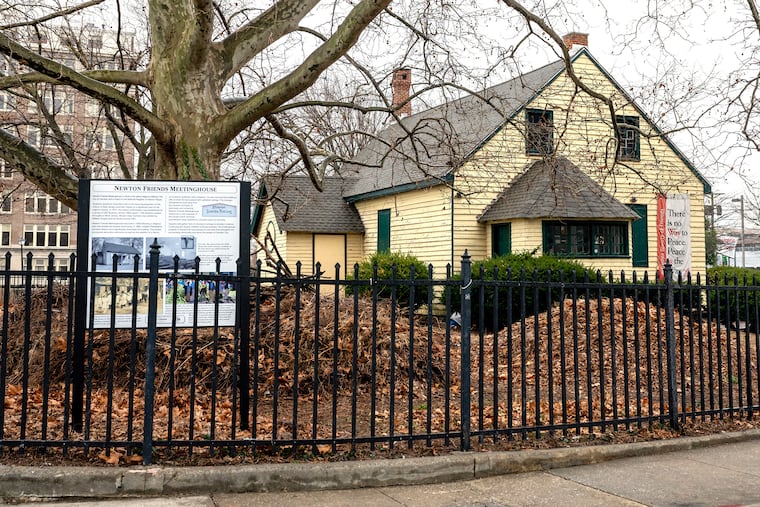Camden’s oldest house of worship faces an uncertain future
The Newton Friends Meeting dates from the late 1600s. With membership and finances dwindling, the meeting seeks a path forward.

Restoration of Camden’s oldest existing house of worship may be put on pause as the congregation struggles with a fiscal crunch and a dwindling membership.
The Newton Friends meetinghouse needs additional revenue to keep the lights on and continue gardening, educational, and other community programs on the site at 808 Cooper St.
“We’ve come to a kind of fork in the road,” meeting treasurer Jennifer Hoheisel told a group of about 20 people, including members, regular attendees, supporters, and visitors, following Sunday’s worship service.
Work to stabilize the structure, install new systems, construct an ADA-compliant restroom, and make other interior and exterior improvements will transform the long-vacant building into a revenue-producing facility that also will serve the Camden community, Newton Friends members said.
The restoration project is funded by grants and does not affect the meeting’s finances.
In the meantime, members and attendees said, Newton Friends needs to attract additional worshipers, as well as more support from Quaker meetings elsewhere in South Jersey.
“The meeting itself is in trouble” as far as attendance goes, Cynthia Kammer, who serves as clerk at Newton Friends, told the post-worship gathering Sunday.
Although worship services sometimes attract a larger group, there currently are just four members and six regular attendees. Members are considering whether to request their meeting be temporarily placed under the care of another, Kammer said.
Financial setbacks
Newton Friends has about $1,000 in monthly expenses, $350 in monthly income, and $1,000 in cash on hand, according to a report by Hoheisel.
Revenue losses in recent years have included the COVID-19-induced closure of a nearby charter school that had paid to use outdoor and indoor space on the meeting property.
And in December, the meeting lost $6,000 in annual rental income when a book distribution and literacy program relocated.
“It’s difficult to do the work at hand because there are so few people. And many, if not most, of us are retirement age or older,” Kammer 77, said. “We’re looking for other people to step up in a collaborative effort to support the final restoration of the meetinghouse for community use.”
Christopher Pensiero, who is the clerk of the quarterly meeting, which includes Newton, Moorestown, Cropwell, and Medford Friends, attended the session.
“Newton is the smallest, but one of the oldest meetings. It had been financially stable and doing great work in Camden for a long time,” he said.
Pensiero said he likes the idea, floated during the group conversation, of creating a “Friends of the Newton Friends” group that could help rebuild membership and resources, so that the meeting can survive on its own.
If that can’t happen, he said, “it may have to be dissolved. And that hasn’t happened around here for a while.”
Restoration is a work in progress
Restoring and repurposing the architecturally significant meetinghouse would provide income to support the meeting. Emergency stabilization and some restoration work have been completed on the wood-frame, early 19th-century building, with more to come in the spring.
The current projects are being paid for with a $104,588 New Jersey Historic Trust grant and $69,000 from other sources, including the Camden County Open Space preservation program.
“Once the temperatures are conducive in the spring, there is money remaining to complete the exterior painting and repairs,” said preservation architect Margaret Westfield, who attended the post-worship session.
Grants still must be obtained to pay for interior work, including replacement of utility systems and construction of a restroom in compliance with the Americans with Disabilities Act.
“It would be great to continue that work now that there’s some momentum,” Westfield said. “But the meeting is dealing with other issues, and the final restoration can wait. It takes [more] people to get done what needs to be done.”
An architectural and spiritual landmark
Newton Friends was established in what is now Camden in 1680, and the earliest portion of the existing meetinghouse was built in 1828.
The school building was erected in 1837 to serve neighborhood children and operated until New Jersey passed laws in 1867 and 1871 providing for free public education statewide.
The meetinghouse has been listed on the New Jersey and the national registers of historic places since 1971; noteworthy modifications and an addition were designed by Wilson Eyre Jr., who also designed the Penn Museum in Philadelphia.
“Quaker buildings tend to be very plain, and it’s totally remarkable that the meeting hired an architect known for Queen Anne and shingle styles,” Westfield said.
Meeting members who share an appreciation for the building and support its preservation said they are confident that a spiritual path will lead Newton Friends forward.
Cassie MacDonald became familiar with Newton Friends while working in the city. She asked to become a member “after it became clear the meeting was in trouble” and was accepted.
“If we make ourselves known and are consistent in our worship,” MacDonald said, “there are many [other] people who might find something they need here.”
Said Kammer: “Our faith has taken us through hard times. We’re resilient. And we take a lot of our wisdom about resilience from Camden.”